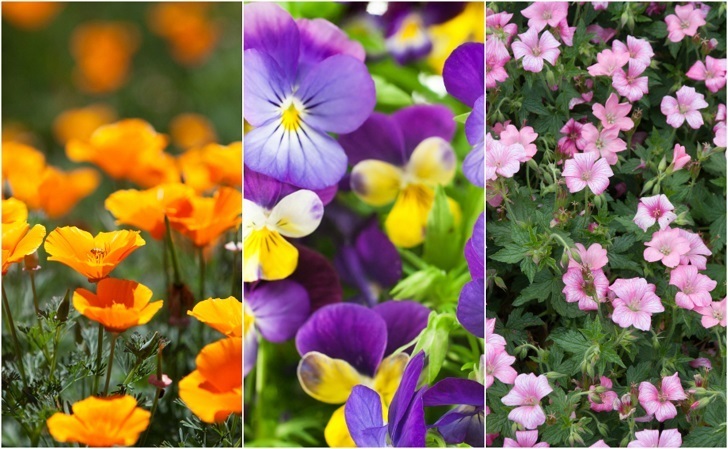
Beginner gardeners can enjoy a colorful and fragrant outdoor space right from the get-go with this list of 18 beautiful flowers that are easy to grow, survive anything and need next-to-no care!
1. Sunflowers
Few flowers embody the very essence of summer quite like the spectacular sunflower!
Growing to between 6 and 16 feet tall, depending on the variety, the annual sunflower is a surprisingly undemanding plant. Simply sow the seeds in a sunny, sheltered spot – providing supports for the stems to prevent breakage.
The hardy sunflower does well in most soil types (except soil that is water-logged) and most varieties are tolerant to heat and drought.
Sunflowers attract bees and birds and will provide you with a bounty of seeds that are high in many essential nutrients like Vitamins E and B1, magnesium and selenium.
2. Lavender
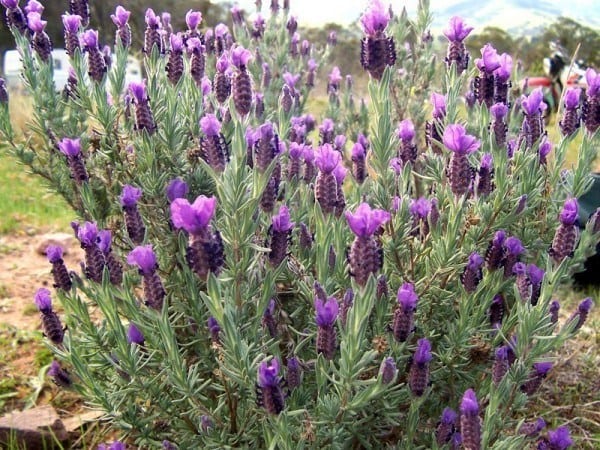
Lavender is a hardy plant that doesn’t require a whole lot of care once established – just one of the many reasons to grow this calming purple flower in your garden. Keep in mind that lavender thrives in sunshine and dry soil, meaning under watering or drought isn’t an issue.
There are several varieties of lavender so make sure you choose one that’s right for your climate. Discover more about growing and harvesting lavender here.
3. Fuchsias
These beautiful and easy to grow plants bring a burst of color to the garden. With so many cultivars to choose from, you’ll have no problem finding one that suits your climate – even those experiencing minus temperatures can grow the ‘Molonae’ fuchsia!
To keep a healthy looking plant, grow it in a shady location and prune back weak and dead growth every so often to encourage new blooms.
4. Pansies
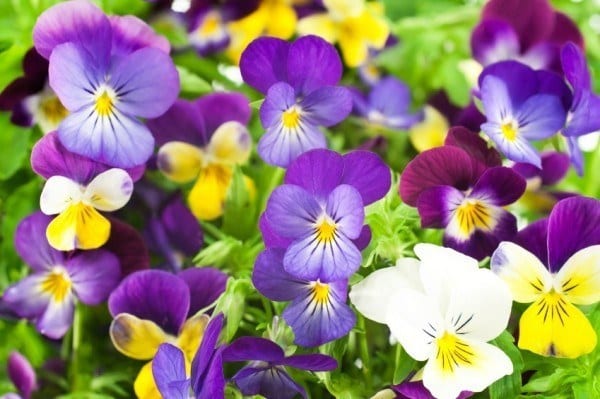
Pansies are garden favorites precisely because they are so easy to nurture – and come highly recommended for beginner gardeners.
To make their care even easier, purchase these bright and beautiful flowers as bedding plants and transplant them directly into the ground. From then on out, they only require a minimum amount of attention to thrive.
The pansy likes rich, well-drained soil, and full sun or partial shade. Deadheading the withered flowers is a must to encourage greater growth.
5. Nigella
Also known as Love-in-a-Mist because of its tangle of fern-like foliage around the flower, the nigella requires minimal maintenance, although it is a short lived plant. However, it self-sows freely so you can enjoy continuous blooms once the seeds have scattered adequately.
Because it adapts to a variety of soil conditions, it’s relatively easy to grow almost anywhere. Once established, it isn’t usually bothered by pests. For best results, sow your nigella seeds directly in the ground, in full sun to partial shade.
6. Lupines
Available in a variety of colors, and growing up to four feet tall, lupines are an attractive way to add color and texture to any garden bed.
Growing lupines is simple! Plant seeds or cuttings in a sunny area with average but well-drained soil. They do best in an area which hasn’t been amended by the application of compost or fertilizers.
These beautiful plants – a type of legume – produce seeds which will re-produce more flowers in subsequent years if not removed from the growing lupine.
7. Calendula
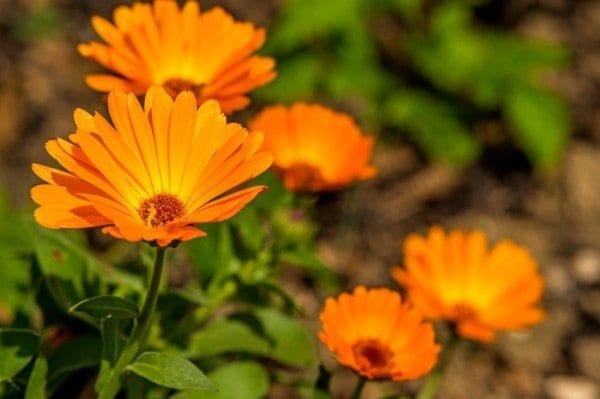
One of the easiest annual flowers to grow from seed, calendula or pot marigold, is a bright and beautiful addition to any garden. You can also use your calendula plant to make a healing and soothing cream.
It adapts well to a wide range of growing conditions – thriving in USDA Zones 2 to 8 as a summer season plant and as an all-round bloomer in hotter zones.
Calendula tolerates any type of soil, although it must drain well and this self-seeding plant prefers full sun to partial shade. Make sure to check out these 14 convincing reasons to grow calendula in your garden!
8. Ornamental Alliums
An unusual yet beautiful bloom, it’s difficult to believe that the ornamental allium is related to humble onions and garlic.
These easy-to-grow bulbs come in a broad palette of colors, heights and bloom times. Ornamental alliums are hardy and undemanding – although they should be grown in a sunlit area. They aren’t fussy about soil type, as long as it is well-drained; they don’t requirement much space and, best of all, they are relatively resistant to deer, voles, chipmunks and rabbits!
Some of the most beautiful varieties of ornamental alliums are the ‘Everlasting’ and the ‘Schubert’ – both of which resemble exploding fireworks.
9. Dianthus
With over 300 varieties of dianthus – including Sweet William, pinks, and carnations – you’re sure to find one you love. One of the best flowers for a fragrant garden, many types of dianthus boast a sweet and spicy smell similar to cinnamon or clove.
You can source hardy annual, biennial or perennial dianthus varieties. They should be planted in full sun, with well-drained soil. Easily grown from seed, the dianthus responds well to midwinter sowing and the seedlings never suffer from shock, no matter how roughly handled!
10. Hardy Geranium
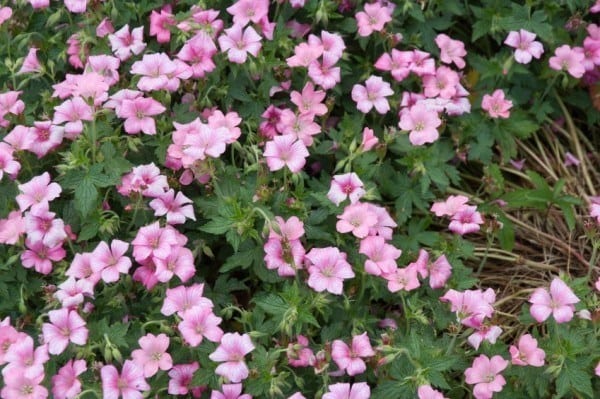
With approximately 500 species of geraniums worldwide – thriving on every continent – there is a hardy geranium for every climate type.
The hardy geranium is resistant to pests and disease, although they require well-drained, fertile and moist soil. They prefer morning and afternoon sun, and can handle partial shade well.
Because they are so successful as a weed-suppressing ground cover due to the large quantities of flowers they produce, a mid-season cut back is a good idea.
Hardy geraniums are easy to grow from seed and even easier to cultivate from bare roots!
11. Cosmos
These tall, frilly annuals – which blossom in an array of colors – are one of the easiest flowers to grow from seed.
Cosmos look beautiful in borders or containers and they attract all manner of pollinators to the garden. What’s more, they make for stunning floral arrangements.
They prefer moist, well-drained soil that isn’t too rich, although they can grow in pretty poor soils too! Heat and drought tolerant, the cosmos can grow anywhere between 18 and 60 inches tall depending on the variety.
When growing from seed, it can take seven weeks until the flowers first appear, after which they will continue to bloom until the next frost.
12. Nasturtium
The quick growing and colorful nasturtiums can be sowed directly into the ground. Soaked seeds will germinate quickly, and do well in even poor soil.
The only thing this low maintenance plant will ask of you is regular hydration – let the soil dry between waterings, although the plant shouldn’t be parched.
Nasturtiums look lovely in containers and window boxes, but they also make great ground cover in borders and beds.
Best of all, the entire plant is edible! Similar to watercress, the flowers have a peppery flavor, while the leaves can be used in salads and the seeds can be pickled like capers.
13. Sweet Pea
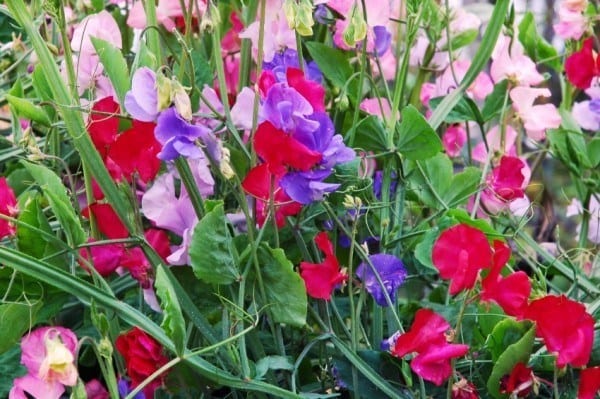
The beautifully scented sweet pea makes a wonderful addition to any garden, particularly as it requires so little care once established.
Seed germination can be a little tricky, but soaking the seeds before planting will see them quickly sprout. Of course, an even easier option is to purchase your sweet peas as plug plants.
Sweet peas like cool, but not cold, temperatures with their heads in the sun and their roots in cool, moist and alkaline soil. (A sprinkling of lime, crushed eggshells or hardwood ashes can all help raise soil pH without too much effort.)
The cut flowers look simply beautiful when displayed in the kitchen or living room.
14. Bachelor’s Button
A hardy, intensely blue wildflower, the Bachelor’s Button is low maintenance and thrives in poor, dry soil.
Sow this drought tolerant annual in early spring, after the last frost. It usually reseeds itself coming back year after year. Plant it in a position where it’s sure to receive morning sunlight, but partial shade during hot afternoons.
Bachelor’s Button doesn’t require too much in the way of watering – it becomes weak and floppy in soggy soil, and can also suffer stem rot and mildew. For a longer blooming season, pinch off wilted heads.
15. Californian Poppy
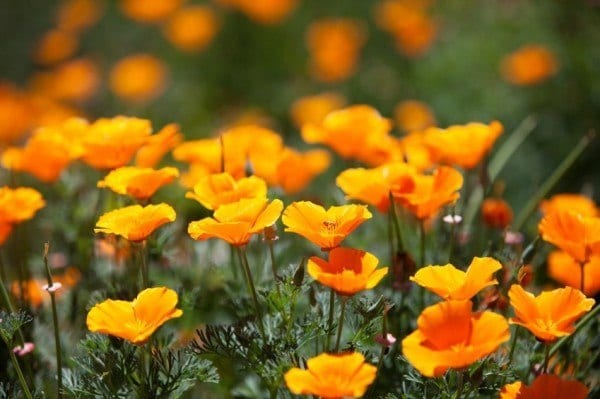
Californian poppies are beautiful bright annuals in reds, oranges and yellows, which thrive in poor, dry or sandy soil and full sun.
They deal well with droughts, so watering will never be an issue. In fact, all you need to do with this incredibly low maintenance plant is to scatter the seeds directly on the soil and watch them thrive!
Californian poppies are also self-seeding so you can enjoy an effortless burst of color year after year, although you may want to deadhead a certain portion of the flowers to maximize blooming.
16. Marigold
Marigolds enjoy their popularity precisely because they are so very easy to grow. Their wide range of colors also helps matters of course – you’ll find them in white, yellow, orange, red and mixed colors.
From miniatures to giant varieties, there is a myriad of marigold varieties so you can select the color and size that is perfect for your flower or container garden.
Marigolds grow quickly from seed. Sow them directly after the last frost in full sunlight (or up to a maximum of 20% shade). They are tolerant of dry, sandy soil, but don’t like to be overly damp.
Pinching young plants encourages a fuller shape.
17. Morning Glory
For a hardy, quick growing vine that requires little care, choose the morning glory! These annuals are self-seeding so you can enjoy them for years to come with minimal effort on your part.
Perfect for covering walls and trellis, these beautiful purple, red, pink or blue flowers flourish in full sun and moist, well-drained soil. Direct sow the morning glory after the last frost date (soaking the seeds overnight first).
18. Dahlias
Growing the beautiful dahlia is a piece of cake! These colorful spiky flowers – grown from small tubers planted in the spring – generally bloom from mid-summer to the first frost.
Dahlias thrive is most climates although they don’t do so well in extremely hot and humid regions. They like sunny positions, particularly morning sun, growing more blooms with 6 to 8 hours of direct sunlight daily. Rich, well-drained soil with a slightly acidic pH will see your stunning dahlias flourish.
